
by Luke Schmaltz | May 20, 2022 | Main Articles
Ground Floor Opinions About Denver’s Meow Wolf Installation
by Luke Schmaltz

Meow Wolf takes visitors through a journey of convergence through the multiverse — a confluence of four separate worlds which collide around the viewer’s senses.
Meow Wolf Convergence Station sits at the crossroad of Colfax Ave. and I-25 like a fortress of the extraordinary — a labyrinth of mind-bending worlds meant to immerse, inspire, and entertain.
The exhibits and attractions therein await to bombard visitors with an unmapped, unpredictable miasma of madness without warnings, wherewithal, or significant signage. The experience lands somewhere between interactive art museum and over-hyped tourist trap. Similar to the institution’s original location in Santa Fe, NM, and the subsequent installment in Las Vegas, NV, this destination is dripping with the artistic input of hundreds of contributors and collaborators — many of which are residents of the Mile-High City. The organization’s official statement is that among the 300+ artists who collaborated, exactly 110 were from Denver.
Whether Denver’s Meow Wolf installation is truly a monument to modern and postmodern art or a sensory overload amusement park on audio and visual steroids is a matter of opinion. These can range from positive to critical to indifferent — depending on one’s perspective and their position on the merits of big business converging with independent artists.
The Repurposing Diorama Maker
Scott Hildebrandt — aka Mr. Christmas — is a Denver-based artist who combines his love for miniatures and holidays into a unique brand of playful creativity. Hildebrandt applied to collaborate with Meow Wolf in 2017 and waited for two years before definitive plans to get to work were made. “In the summer of 2019,” he begins, “I began submitting plans, diagrams, specs, and requirements of the space that I would need. Then, over the rest of 2019, there were several meetings with lighting and sound teams to define my needs for this project,” he explains. “There was quite a bit of momentum at the beginning of 2020, until the pandemic halted everything. [By] late summer of 2020, I was able to finally get started by collecting materials mocking up my design. By fall, I was assembling and designing my concepts and building the framework. At the beginning of 2021, I was in full production mode with a hard fast deadline of May 1st to meet final inspections. For four months straight, I worked seven days a week, around 8 to 14 hours a day to make that deadline.”
Hildebrandt says he considers Meow Wolf to be a hub of artistic merit and an outstanding Denver treasure. “I truly believe that Convergence Station is an art installation and definitely an

Scott Hildebrandt specializes in miniatures and dioramas but his Meow Wolf collaboration is a macro-installation of his work.
art experience,” he says. “The whole venue encourages
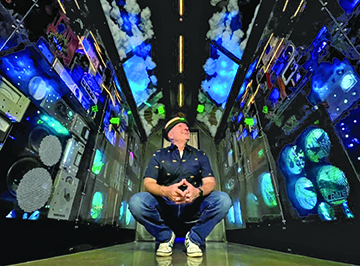
Scott Hildebrandt’s Meow Wolf installation is a life-sized diorama made of repurposed materials.
playful curiosity and invokes imagination with art in a way that no other museum or gallery can. Denver is truly blessed to have something like this in their very own backyard. Not only is it good for Denver, but it is very good for the Denver art scene. Convergence Station showcases 110 Denver artists and shows how strong the Denver arts scene really is. Since I’ve started my journey as a full-time artist, I have had the opportunity to meet so many wonderful artists here in Denver. On any given First Friday, you can explore galleries all over Denver showcasing both new and old artists and be truly amazed at the talent that we have here,” he says.
The Insider
Mar Williams is a Denver illustrator who became involved with the Meow Wolf corporation in 2016 and was subsequently part of a 2019 class-action lawsuit against the company for discrimination. Williams is transgender, and alongside several other individuals had complaints against the company (a B Corporation) for unfair practices toward employees based on gender.
While the matter was resolved in early 2020, Williams maintains a distinctive opinion about Meow Wolf’s role in the arts community. “I’d like to include my earlier quote to Westword, which safely summarizes a lot of my perspective,” Williams says. “My hope is that they do more to lift individual artists than to absorb them.”
Williams goes on to explain, “To expand on a piece of that; Is Meow Wolf authentic art? I think it’s important to separate the brand from the art for that question. Maximalism and the ironic sincerity of meta modernism are ultimately hollow when coming from a brand, because the vulnerable human point of self-reference isn’t sincere or simply doesn’t belong to it. It’s like the Wendy’s (fast food chain) twitter account being edgy. It doesn’t mean anything. I think there’s plenty of authentic art and artists in that space, and while the bigger, flashier, more profitable container may drive more traffic to it, the container isn’t the art, and corporations aren’t collectives.”
The Multimedia Creative
While artist Dice 51 currently lives in Denver, he is originally from Albuquerque, NM. While he begins most of his work with pens on plain paper, that’s hardly where it stays. The end result of his continued attention to any particular piece can result in p

Mar Williams was one of the first Denver artists to become involved with the corporate megalith, and has distinct opinions on art that is purveyed by big brands.
ens, pendants, wood stacks, laser-cut wood-stained pieces, and more.
Dice’s native New Mexican heritage prompted him to apply to be a Meow Wolf collaborator. “I first started working with Meow Wolf through the events team. I would organize live art and vendors for certain shows at the Santa Fe exhibit, bringing in artist friends from around the country to display their work,” he explains. “I grew up in Albuquerque, so as a local artist in New Mexico I knew I wanted to contribute to Meow Wolf. Eventually with [some] help I was able to apply for the Denver exhibit,” he says. “I spent close to three months working directly on my piece for the exhibit, and the application process was about two years long. I did most of the design and building in the months before installation, then spent two weeks installing the piece.
Dice contends that the experience was unique but positive. “I’ve never worked on something so big,” he begins. “Luckily, I got full creative control once my proposal was accepted, so I could really dive into the creative process without any outside influences. There’s so many people that were involved that I still haven’t met. The result was amazing, I still stumble on work that I’ve never seen there whenever I get a chance to wander.”
Part of Meow Wolf’s brand is intertwined art installments without signage or explanation, leaving uncredited collaborators to take solace in the fact that they got paid to be a part of something big and beautiful. While every artist is credited on the Meow Wolf website, some were determined to put their personal stamp on their work so that curious visitors could find them if necessary. “I wish I was able to attach my name to my project more,” Dice says. “I had to get creative with it, so I hid it all throughout the piece and had a full write up displayed with my pieces in the giftshop. Some other artists fou

Dice 51 next to his Meow Wolf collaboration. The New Mexico native-turned Denver resident relishes his experience contributing to Meow Wolf Convergence Station.
nd great ways to get their name on their piece. I know one had a giant symbol made of QR codes in his room, and the QR codes lead to his website. I think something like that is the best move, something subtle enough it doesn’t take away from the art, but direct enough to actually connect to the millions of people who go to the exhibit. I definitely see Meow Wolf as an art installment. It’s like a giant art piece that you can walk inside of and be a part of. From the exhibit as a whole, to the tiny details hidden throughout, the entire experience is led by artists.”
The Outsiders
Speaking of galleries, one local artist who has curated a prominent presence among the First Friday visual art crowd goes by the moniker of W. Max Thomason. He holds the Meow Wolf phenomenon in ho-hum regard, saying, “Simply put, it is commercial art. No matter what title, label, and/or designation you give it, it is only commercial art. It is not fine art. Nor do I think it should ever be considered fine art. In all fairness though, having never spoken with the designers, creators, or decision makers I cannot say if it was ever meant to be considered fine art, but I do think it should not be viewed or judged as thus,” he contends. “If it inspires, motivates, or speaks to someone, fantastic. It has never done so to me. I think [the] assessment of a modern, repackaging of amusement park-style entertainment is a fair and accurate elucidation.”
Meanwhile, while most of the art world is in some way concerned with Meow Wolf, there are those who remain blissfully unaware of any such phenomenon. One such individual is Abe Brennan — a Denver musician and illustrator, enjoying a post-2020/2021 windfall of design work creating T-shirt art for bands. When approached about Meow Wolf, he blinked, shrugged and said, “Huh? Meow what? Never heard of it.”
Regardless, should you aspire to experience this immersive experience firsthand, be prepared to pay a hefty admission fee. Tickets are priced at $44 to $49, depending on age. Get your money’s worth by choosing an early arrival time and plan on being there for at least a few hours. Then, prepare yourself for a wild, nonstop hyper-stimulating, one-of-a-kind ride. Whether you’re an artist or a spectator, this destination has something for everyone.

by Luke Schmaltz | Apr 21, 2022 | General Featured
“No one is immune from addiction; it afflicts people of all ages, races, classes, and professions.”
 by Luke Schmaltz
by Luke Schmaltz
The fundamental allure of using drugs is state change. The human nervous system is a pleasure-seeking construct. In the relentless pursuit of gratification, the human brain has developed an ability to manufacture state-changing compounds such as dopamine and oxytocin.
Modern ingenuity is locked in an undying quest to replace all physical and mental exertion with painless luxury. In doing so, it has removed all effort from dealing with pain and mental unrest and created a smorgasbord of delights for every proclivity, every unique brain chemistry, and every personality.
According to the National Institute for Children’s Health Quality (nichq.org), “Over 20,000 babies are born each year dependent on illegal or prescription drugs” having inherited their mother’s addictions while in the womb. Regardless, every person in the developed world, at an early age, will be bombarded by the concept of ingesting substances that are designed to fix problems and change the way they feel. Through television, internet, streaming video, audio programming, pop culture, peer pressure, and parental behavior — most people come to understand the concept of getting “messed up” at an early age.
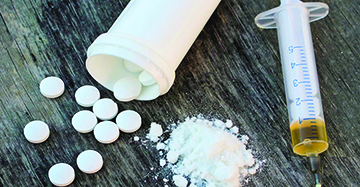
The pervasive inclusion of fentanyl in illegal street drugs and imitation prescription pills is increasing overdose deaths exponentially.
Those among the populace unfortunate enough to be born with certain types of brain chemistry, an addictive personality, or a wide variety of mental issues can become hooked on any number of toxic substances. These can include alcohol, tobacco, methamphetamine, heroin (opioids), cocaine, methadone, and more. Much more.
The specter of addiction hangs over Western society as a constant reminder of how capitalism is hardwired to accommodate the penchant for instant gratification. A culture of escapism and sensory overload is perfectly suited to appease the human tendency to embrace denial and avoid dealing with problems head on.
Start Prevention At An Early Age
Just as children are taught to look both ways before crossing the street and to avoid interacting with strangers on said streets, the topic of addiction should be presented and prioritized with the same immediacy. Yet, Western society, in its infinite irony, is harming kids by keeping them in the dark in an effort to protect them from life’s harsh realities. In most instances, kids simply have no concept of how easy it is to get hooked and the possible outcomes — most of which can be anywhere from unfortunate to tragic.
Education on drugs and addiction starts at home, whether it is through candid conversations between parents and kids or through parental neglect to broach the subject. The former takes the hearsay and mythos out of the equation and creates healthy dialogue between parents and kids. The latter leaves curious children to seek answers elsewhere through their peers, social media, or by observing parental behavior — all of which can be misleading. According to a 2021 report published by SAMHSA (Substance Abuse and Mental Health Services Administration), “If you talk to your kids directly and honestly, they are more likely to respect your rules and advice about alcohol and drug use. When parents talk with their children early and often about alcohol and other drugs, they can protect their children from many of the high-risk behaviors associated with using these drugs.”

The American Heart Association provides sobering insight into the harmful effects of nicotine.
The same report explains that by the age of 15, 50% of kids will have tried alcohol and the same number will have tried an illegal drug by the time they are seniors in high school. State-changing substances are pervasive and inescapable, so the ideal way to deal with them is to take the guesswork away from inquisitive children and explain, in clear language, that drugs can easily harm them, poison them, and kill them.
Escape The Vape
Nicotine is highly addictive and is now available in seemingly harmless vapor form — packaged in flavors such as bubble gum, sweet tarts, gummy bears, and chocolate — which are highly appealing to kids. Since combustion is not involved, vaping can seem like a consequence-free way of obtaining a nice buzz, but the reality of the situation is that, according to the CDC (Centers for Disease Control), “Nicotine can harm the developing adolescent brain and the parts of the brain that control attention, learning, mood, and impulse control.”
Understand The Impulses

Peer pressure can be a big contributor to what causes kids to use drugs.
A child is compelled to use nicotine for the same reasons an adult reaches for a pack of cigarettes, temporary relief from depression and anxiety. You can prevent your kids from getting hooked on nicotine (which can lead to harder drugs) by pinpointing circumstances which are causing stress in the child’s life. Confronting these issues head on and exploring healthy ways to cope such as therapy, exercise, and communication can prevent a child from developing an addictive personality, and it can also strengthen the relationship between children and their parents. Mitigating the fallout from exposure to nicotine and habitual use, according to the American Heart Association, is to establish a comprehensive nicotine-free philosophy which includes vaping, chewing tobacco, and cigarettes. If kids are smoking, it is important to start a dialogue and find out why. The AHA says, “Instead of punishment, offer understanding and help to resist the dangerous lure of tobacco use and addiction.”
Take A Hardline Approach
The defelonization of many hard drugs such as crack cocaine, methamphetamine, and the deadliest of all — fentanyl — is further increasing their availability. If a kid wants to try any one of them, the fact is they don’t have to try very hard to get their hands on some dope. Currently, the establishment’s passe’ attitude toward drug use is sending a message to kids that it’s really no big deal to get high all the time. By accommodating drug addicts with so-called “harm reduction” policies, they are making it an everyday affair for otherwise healthy kids to take drugs, get hooked and possibly overdose and die. Just as adults tell their kids not to drink bleach (poison) and swan dive off 100-foot-high cliffs, adults who want to keep their kids away from addiction should consider talking to their kids often and at great length about the clear and present danger of getting high. This is especially cru

Babies born dependent on drugs suffer from NAS (Neonatal Abstinence Syndrome), a type of opiate withdrawal.
cial with the advent of Fentanyl — a compound which, according to Colorado.edu, is “50 to 100 times more potent than heroin or morphine.”
Kill The Pills
Additionally, the undying popularity of over-the-counter drugs has created a market for counterfeit pills — most of which contain fentanyl. While the pharmaceutical industry is finally being regulated after getting millions of people hooked on their products and claiming untold amounts of human life, the monster they created has taken on a life of its own. The demand for pills that make you feel better has become part of the permaculture, and if people can’t get them legally, they will simply find another way.
The Western medicine approach to mental illness takes the path of least resistance; misdiagnose, overprescribe, and move on to the next patient. The idea of delving into an afflicted person’s unique circumstances and getting to the root of their problems has been deemed by many, both subjects and practitioners, as too time-consuming and simply too damn hard. Thus, the motto, “Take two and call me in the morning.” The idea that feeling better and getting away from your troubles is as easy as unscrewing the lid to a child-proof bottle is flat-out false and should be stricken from the narrative.
Kids should be told, in no uncertain terms, that life can and will be hard sometimes, and staying clean takes constant awareness and vigilance. Pursuing chemically-induced state-change can really screw a person up, can lead to an untimely death and a life-changing tragedy for a family. Tell them the truth, they can handle it.
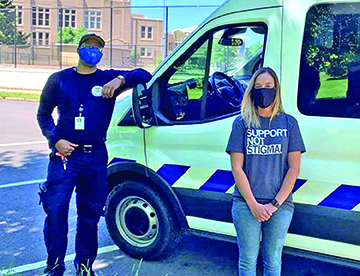
by Luke Schmaltz | Apr 21, 2022 | Main Articles
“What can oppose the decline of the west is not a resurrected culture but the utopia that is silently contained in the image of its decline.”
 by Luke Schmaltz
by Luke Schmaltz
On the evening of April 5, 2022, Lowry United Neighborhoods (LUN) hosted a town hall meeting at Eisenhower Chapel to address widespread concerns about issues stemming from Denver’s unhoused problem.
The panel of speakers represented a cross section of agencies and organizations working directly and otherwise to have a positive impact on the unhoused crisis. The panelists included:
- HOST (Housing Stability and Homelessness Resolution): Deputy Director, Angie Nelson
- Denver City Attorney’s Office: Director of Prosecution and Code Enforcement, Marley Bordovsky
- Salvation Army: Major Richard Pease and Denver Metro Social Services Director Christine Baluyot
- STAR (Support Team Assisted Response): Operations Manager, Carleigh M. Sailon
- Colorado State Senator, District 31, Chris Hansen
Additionally, Denver City Councilwoman Amanda Sawyer (District 5) was on hand to answer questions and offer commentary.

STAR (Support Team Assisted Response) responds to non-violent 911 calls in place of police officers.
The briefing for the meeting stated: “LUN presents this discussion because of widespread frustration that millions of dollars and years of work have brought only fragmented remedies. Along with homelessness, comes health and safety impacts harmful to those who live on the streets, as well as to other citizens of Denver.
“LUN has assembled this panel of local leaders to help us better understand the challenges for the homeless and unhoused in our city and for the agencies who serve them. The panel will discuss the spectrum of services and housing options designed to assist unhoused individuals in Denver and what those efforts have achieved.”
Denver7 Reporter Russell Haythorn acted as discussion moderator. The following is a condensed version of the 90-minute meeting, highlighting some (but not all) key points made by each speaker.
Angie Nelson — Housing Stability and Homelessness Resolution
The HOST Deputy Director holds a master’s degree in social work as well as a bachelor’s degree in pre-professional counseling. Administrators appointed Nelson to her position in March of 2021. Nelson was thorough in explaining the scope of the unhoused issue and laid out, in great detail, what her organization and others working in this field are up against. “We invest resources and help to create policies and empower partnerships to help across the whole spectrum of homelessness through housing opportunities” she began. “We are helping keep folks in the homes they have through programs such as rental assistance, utility assistance and home repair and modification. We help to quickly resolve episodes of homelessness through a variety of programs such as street outreach and shelters to programs such as supportive housing. Some of our key performance measures are that we hope to see a 50% reduction in unsheltered homelessness in the next five years.”
Moderator Russell Haythorn (questions relayed from audience members): “How does HOST control, monitor, and enforce policies regarding substance abuse and also, does HOST help connect its clients with resources for mental health and substance abuse treatment?”
Angie Nelson: “Within our programs we seek to make sure there is a holistic response. So, our housing programs aren’t housing only, they are housing first, but they are also there to support services that are going to help someone meet their needs when it comes to mental health or substance abuse so that people have the support they need to get stable and stay stable.”
Marley Bordovsky — Denver City Attorney’s Office
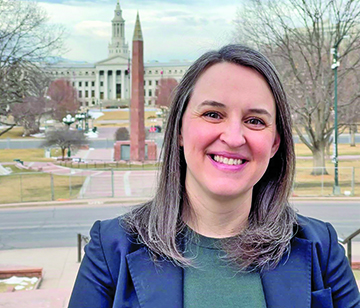
Angie Nelson is Deputy Director of HOST and is contending with a massive, complicated issue.
Moderator Russell Haythorn: “Under what circumstances does the City Attorney’s Office become involved with individuals who are experiencing homelessness?”
Marley Bordovsky: “I am at a cleanup most every day of the week to make sure our city agencies are solid in how they are conducting themselves and making sure they are abiding by all the settlements they have to abide by,” she began. “So, we provide boots on the ground legal guidance for the city agencies involved in the process. I want to highlight … a lot of our specialty dockets that are instrumental in crafting and creating with our court partners and city partners and also in staffing with attorneys. We have an outreach docket that we staff every other Wednesday. It started at the Denver Rescue Mission where we actually held court during Covid. The concept is to bring the court to where you are. It’s one thing to say, ‘You need to be in court on this day and if you’re not here we’re going to issue a warrant for your arrest.’ A lot of folks can’t make it down to the courthouse for a lot of reasons, whatever it might be, so this is an attempt to bring court to you so that it is a much lower barrier. We have a wellness docket that is a way to divert you out of the criminal justice system. There is a court component of it, where if you have outstanding warrants, we can help clear those warrants for you so you’re not getting arrested and going back into the cycle.”
Bordovsky supplied attendees with a two-sided handout explaining the complexities, constraints and parameters that most workers must follow when conducting cleanups of public encampments. “ For the cleanups we do three times a week in general around the city, there are some serious legal constraints that we abide by,” she began. “We have to post a large-scale cleanup for seven days minimum. It’s very structured as to how that posting is done. [Notices] are put on the tent, put around the perimeter, we have to define the perimeter of the area we are cleaning up. On the back of it is always the services that Angie’s team (HOST) provides for folks if they are interested.”
The Salvation Army — Major Richard Pease and Denver Metro Social
Services Director Christine Baluyot
Major Richard Pease offered a brief summary of his organization before answering questions. “We are an international organization,” he began, “But here in the United States (last year) we touched the lives of about 25 million Americans through our social services programs, which means nationally, outside of the Federal government, we are the largest provider of social services in the U.S.”
Moderator Russell Haythorn: “Describe specific programs and intended outcomes for those experiencing homelessness.”
Richard Pease: “In Denver, we have a family shelter called the Lambeth Family Center which is in west Denver. It currently has 20 units for families experiencing homelessness. It’s a 90-day program with the intent of getting folks stabilized in their housing. From day one they meet with case managers to help them get to permanent stable housing. About 74% of families who enter into our programs exit into stable housing which is well above that national norm for that type of program. We are in the process of developing an expansion on Alameda (we call it the Alameda Campus) that will include a new, state-of-the-art 85-unit program for families. Our goal is to get that built and open by the end of 2024.”

Lowry United Neighborhoods (LUN) is the official RNO (Registered Neighborhood Organization) of the district.
Christine Baluyot: “Some things we have learned about successfully moving people who are unhoused into stable or permanent housing are [in] the Denver Housing Collaborative. This is a really exciting approach that is really innovative. It’s a partnership between HOST and a few different organizations here in Denver (Colorado Coalition, Urban Peak, and others). We had this [big] increase in people experiencing homelessness, filling up hotels, taking up shelter beds, and we were not able to move them out. It [the Collaborative] came about as a result of a conversation between all of us partners and the city. As a result, we have been provided the funding to have case management teams, housing navigation teams — all of us working together as a collective which has never happened before. There is funding to be able to get people directly into housing and it is not tied to a lot of the restrictions of most of the Federal funding we get.” Baluyot went on to explain why this particular type of funding versus Federal funding is so effective — because it is available immediately and can be implemented with expediency. “This is the key reason as to why Crossroads has been so successful in getting people into housing, because we can say, ‘Hey, do you want housing? They say yep and the next week, they are in housing.’”
STAR (Support Team Assisted Response) Operations Manager Carleigh M. Sailon
Moderator Russell Haythorn: “Tell us about STAR and what initiatives STAR is involved in.”
Carleigh Sailon: “STAR [is] a civilian response program that pairs a mental health clinician with a paramedic or EMT and they are dispatched to low-risk, low-acuity calls coming into the 911 system. While we are not just a homeless outreach team, we focus on resource requests, transportation requests, behavioral health issues, substance abuse issues — anyone who is experiencing some sort of crisis in the city and county of Denver and calling 911 or police non-emergency for assistance with that crisis. About 60% of the individuals we have responded to in the last month have been unhoused. When a call comes into the 911 communication center, it screens for risk. Is there a weapon, is there an injury, is there a time-sensitive issue where we have to send an armed response? Or is someone safe enough to wait for a non-emergent response? Is there a public safety issue? Has a crime been committed? If all those answers are no, then our civilian call-takers and dispatchers can start thinking about if STAR should be sent. While police, fire, or EMS are sometimes the right answer, they are not always the right fit for every scenario. [We are] trying to send folks who have the appropriate expertise [for] the issues we are facing.”
Colorado State Senator Chris Hansen
Moderator Russel Haythorn: “Do you agree that Denver and Aurora carry the primary budgetary responsibility for providing housing and services for those experiencing homelessness?
Senator Chris Hansen: “There is an important state role that is being played in responding to this crisis we are in. We have built a system that has a lot of local governments being the front door for providing services, but the state has a super important role to play. I have the job of leading the state Senate on the Joint Budget Committee and the Senate Appropriations Committee. We are making some very big budgetary decisions and I have some great news to share with everybody tonight. There is a very large response from the state budget to help local governments — Aurora,
Denver, etc. It is a statewide crisis, and we are trying to respond to that in a statewide way. In this budget, we have set aside 200 million dollars for addressing the crisis directly. About half of that is going to end up coming to Denver and Aurora. On top of that, accommodation of state funds and Federal AARPA dollars, the relief act that was passed last year, Colorado received about four billion dollars. We are going to be using about a quarter of that for mental health supports, behavioral health supports, addiction services and housing programs across the spectrum. So, the state is taking some comprehensive steps in this budget.”
Denver Councilwoman Amanda Sawyer, District 5
Moderator Russell Haythorn: “Given that the city has provided funds for the Denver Rehousing Collaborative, are you tracking subsequent reduced costs in GDPR visits, vagrancy, an
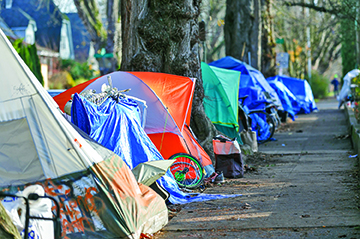
Marley Bordovsky of the Denver City Attorney’s Office explained the complexities of conduction sweeps of homeless encampments in Denver.
d has there been enough data? What are you seeing?
Councilwoman Amanda Sawyer: “This is a huge issue and what you’ve heard tonight is probably a third of what actually goes on behind the scenes in terms of all the different programs, responses, and opportunities that there are. In terms of the question that was asked, we don’t have the data yet to show whether it’s working or not. I will tell you, the most incredibly frustrating thing for us is when we see no response at all or a slow response when it feels like it should be a quick fix. It feels like it should be something very simple, and we make it a lot more complicated on the governmental level. Things are so siloed, organizations aren’t talking to each other, I know you feel that, and we feel it too — especially when we hear from someone who is unhoused [say] ‘I was unhoused in Greenwood Village and they gave me a bus ticket to Denver.’ I think what you have heard tonight is the start of real solution-oriented conversations. We know there are a number of residents experiencing homelessness who need mental health support services. There just aren’t enough beds in the state for them. We know there’s a portion of people who need long-term substance abuse recovery support. There aren’t enough beds. But the conversation is starting and at the end of the day the city doesn’t have the financial resources to solve homelessness on our own. We have to have state support. We have to have federal support. Right now is an extraordinary time because we have that funding available. We don’t have the data yet to show this is working. It’s gonna take time to build more facilities and more beds. Senator Hansen mentioned there is a 250-bed program that is working really well. We have approximately 4,000 homeless residents in Denver. We would need 16 of those facilities to be able to support the homeless community.”
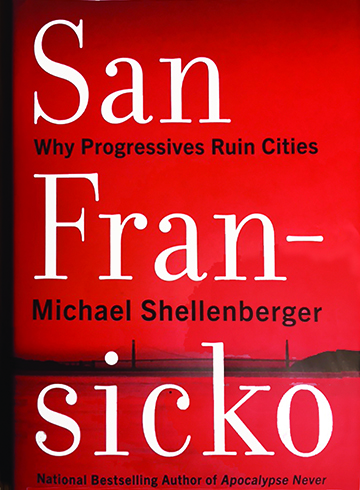
by Luke Schmaltz | Mar 18, 2022 | General Featured
“Progressives want livable, walkable cities, but by allowing the continued operation of open-air drug scenes, they are making cities unlivable and unwalkable, as well as inhumane.”
 by Luke Schmaltz
by Luke Schmaltz
In his recently published 350+ page opus, author Michael Shellenberger tackles the daunting task of unwrapping a multi-layered crisis which has reached a critical state in California’s City by the Bay.
For those who may be unaware, San Francisco, CA, is a city in the grips of a social, political, and humanitarian nightmare. Decriminalization of illicit drugs and mass adoption of progressive “harm reduction” policies have backfired, plunging the city into an epidemic of addiction. One resident, business owner Adam Mesnick, is quoted as saying, “What’s happening is not even liberal. It’s not realistic. It’s fantasy land. This is a severe drug addiction crisis that needs greater intervention or everyone’s just going to die from fentanyl.”
San Franshitsco
 Shellenberger describes how homelessness and rampant drug abuse are coupled with a statewide housing market that is grotesquely lopsided. This is apparent by the skyrocketing rental rates and property values which are pricing out many average citizens — even those with full-time jobs. The result is a populace with a large percentage of “unhoused” aka “homeless” people. In 2019, over 30,000 incidents of public defecation were reported in San Francisco, while California as a whole was found to account for 51% of all unhoused people in the entire United States.
Shellenberger describes how homelessness and rampant drug abuse are coupled with a statewide housing market that is grotesquely lopsided. This is apparent by the skyrocketing rental rates and property values which are pricing out many average citizens — even those with full-time jobs. The result is a populace with a large percentage of “unhoused” aka “homeless” people. In 2019, over 30,000 incidents of public defecation were reported in San Francisco, while California as a whole was found to account for 51% of all unhoused people in the entire United States.
Harm Induction
Shellenberger exposes “harm reduction” sites and so-called “Safe Sleeping Spaces” as the open-air drug scenes that they are. “Harm reduction” is a term used for government-approved areas which supply everything (equipment-wise) an addict needs in order to successfully inject narcotics such as methamphetamine, heroin, and fentanyl. NGO (non-governmental organization) workers provide addicts with tourniquets, cooking kits, syringes, and needles in an effort to somehow “reduce harm.” Shellenberger calls the practice what it truly is — “harm induction.” These NGOs are key drivers of the homeless epidemic, disguising a sadistic policy of aiding addiction behind the auspices of altruism.
Housing First
Shellenberger shines a harsh light on “housing first” which is the battle cry of many homeless advocates. This line of thinking advocates the reduction of access to overnight shelters and instead, insists on housing for addicts and mentally ill people without requiring sobriety, medication, and treatment. Shellenberger presents evidence that this policy does not effectively address the core issues which cause homelessness. To the contrary, by taking treatment for mental illness and drug addiction out of the equation — the issue spins further out of control.
A Huge Industry
Shellenberger goes to superhuman lengths to uncover, document, support, and reinforce the fact that homelessness and open-air drug scenes across the state are worsening in spite of the fact that taxpayer-funded spending on the issues is at an all-time high. The Homeless Industrial Complex, as absurd as it may sound, is very real and very much as counterintuitive and dysfunctional as the title suggests. While hundreds of millions of taxpayer funds are siphoned into this system, half of the money goes to staff salaries. It does not take a genius to realize that if they fix the problem, the cash cow is essentially taken from the milking parlor and put out to pasture.
A Legislative Nightmare
San Fransicko also presents a smorgasbord of political abominations which are adding fuel to the fire. Specifically, the decriminalization of the possession and use of illegal drugs is making it easier than ever for dealers to blatantly serve their market without fear of penalties. Meanwhile, deliberate reduction of the severity of crimes such as shoplifting, burglary, trespassing, and grand larceny has created a black-market industry which favors criminal behavior which is used to support addiction.
Crazy Town
Shellenberger further demonstrates how an unaddressed mental health epidemic is not only a miscarriage of the civil duties of elected government officials, but their pawning it off onto NGOs is downright irresponsible. The simple fact of the matter is that allowing those with untreated mental illness to openly and freely obtain and inject themselves with methamphetamines, fentanyl, and heroin is in no way a solution to a very serious problem.
A Viable Solution
Shellenberger goes on to suggest a comprehensive treatment solution for the mental health crisis via a plausible institution he dubs “Cal-Psych” which would “efficiently and humanely treat the seriously mentally ill and addicts, while providing housing to the homeless on a contingency-based system. Cal-Psych’s CEO would be best-in-class and report directly to the governor. It is only in this way that the voters could hold the governor accountable for the crises on the streets.”
Whether Shellenberger will be taken up on his offer to provide a plausible solution is anyone’s guess. Regardless, if homelessness, open-air drug scenes, rising crime, and increasing danger in your city concerns you, San Fransicko is required reading.
Image by article author
Michael Shellenberger exposes the flaws of a system gripped by addiction, psychosis and inhumane conditions.
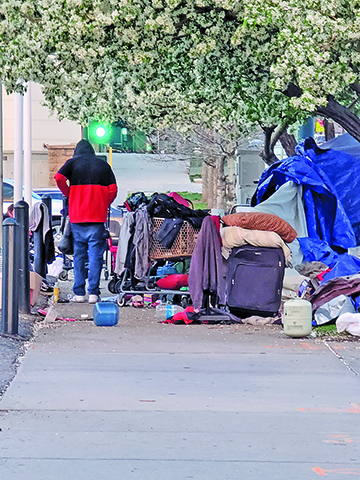
by Luke Schmaltz | Mar 18, 2022 | Main Articles
“Well, if there ain’t gonna be any rules, let’s get the fight started.”
 by Luke Schmaltz
by Luke Schmaltz
Terry Hildebrandt, PhD, is at war. The Denver district where he lives — the Golden Triangle — is anything but a gilded community of urban bliss. On any given day, he encounters the detritus of illegal campers which can include feces, trash, burned up tents, used needles, and more. At all hours of the day and night, Hildebrandt contends with fighting between encampment tenants, incessant screaming, blocked sidewalks, theft of businesses and residences, sexual abuse, and physical altercations which threaten his safety, that of his neighbors, and just about anyone else who enters the area.
Two Steps Back
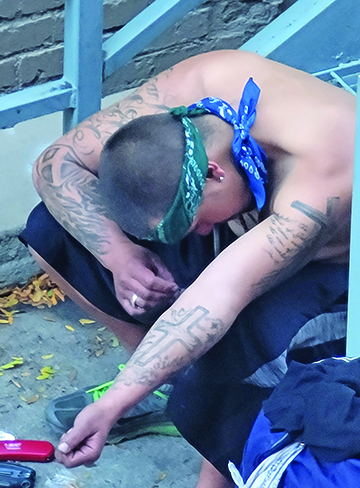
The alley behind Hildebrandt’s office has been dubbed “Heroin Alley.”
The latest installment of feckless legislation poised to exacerbate spiraling crime was signed into law by Governor Jared Polis in early July 2021, and enacted on March 1, 2022. For Terry Hildebrandt, the most concerning features of Senate Bill 271, the Misdemeanor Reform Bill, “is that the law now allows certain felons to possess guns, making it harder for police to remove guns off the streets, due to a change to Colorado Revised Statutes Section 346: 18-12-108 regarding possession of weapons by previous offenders,” he explains.
“Previously, all convicted felons were prohibited to buy or possess firearms. Now, many felons will be allowed to possess firearms, unless they were convicted of Victims’ Rights Act offenses, such as murder, child abuse, and sex assault. For example, this means all previous offenders convicted of felonies that were related to drugs, burglary, arson, and many other reasons will now be allowed to possess guns. Both 18th Judicial District Attorney John Kellner and Denver Police Chief Paul Pazen have publicly expressed serious concerns about SB21-271 and the likely impact it will have on crime rates in Colorado due to more felons being allowed to possess guns.”
The New Skid Row
Meanwhile, Hildebrandt is fighting for the sanctity of the downtown Denver community at large and for the dignity of those who choose to call the Golden Triangle home. Defelonization of the possession of illegal drugs and use of illicit substances, along with the neutralized authority of a Denver Police Department, has turned his district into an urban hellhole. “During the summer of 2021,” he begins, “I had to call 911 to report a man passed out in the alley right by 10th Ave, laying in the way of traffic on the hot concrete. The man could have been run over by a car since that is a busy alley. The Fire Department arrived quickly to check on him. It was around 95 [degrees] that day, so heat stroke was a real possibility,” he says.
Hildebrandt continues, “In 2021, we had a lot of heroin and meth open use in the alley right outside my home and business, which I renamed to Heroin Alley. I have dozens of photos of addicts with heroin needles in their arms and toes and smoking meth and fentanyl. We regularly found used needles all over in the Golden Triangle neighborhood. I was calling 911 up to five times a day to report open drug use and other health crises in my neighborhood. In 2021, I joined forces with a nonpartisan, diverse group of like-minded people, to cofound the nonprofit, Citizens for a Safe and Clean Denver,” he explains.
Complicated Circumstances
Hildebrandt is quick to point out he is not simply condemning the dangerous conditions in his community. He is instead, pointing to contributing factors, such as how many of his property-owning peers choose to simply look the other way rather than insist upon the city doing better. The current policy is for authorities to offer treatment services and shelter to the unhoused living in tents (which is almost universally declined) rather than insist on it — especially for people suffering from addiction and/or severe mental illness. “I see no excuse left to ever tolerate allowing anyone to rot on the street in an illegal tent to overdose and freeze to death,” he says. “How is there any dignity for the unsheltered in allowing dangerous, illegal enc

The Golden Triangle district in downtown Denver is dangerous to all residents, housed and unhoused.
ampments to remain?”
“The sad part is that Denver can find shelter for everyone on the street,” Hildebrandt says. “Skye Stuart (Legislative Director & Sr. Advisor for Policy & Legislation, Mayor’s Office) at Public Hearing: CB 21-0592, said, ‘I do want to be clear that we do have hundreds of beds available every night. If every person off the street wanted to come in, would we need to do some things — like open some rec centers — absolutely, but we do have some flexibility in our system that will accommodate for that.’”
Passing The Buck
Meanwhile, people who are arrested for offenses such as drug dealing, burglary, trespassing, automobile theft, sexual assault, harassment, and other crimes are being inexplicably released by the courts on PR (personal recognizance) bonds in a matter of just a few hours after being detained. Hildebrandt has voiced his concerns to top officials, stating, “We met with District Attorney Beth McCann, and she blamed the judges for releasing accused criminals on PR bonds. McCann took no responsibility for the dramatic increase in accused dangerous criminals being released on PR bonds while awaiting trial, saying that the judges set bail — not the DA,” he says.
Hildebrandt continues, “McCann also told us that she has no data readily available to us to understand which judges are to blame for this mess. I am deeply frustrated and disappointed in the lack of accountability in the judiciary. The public has no easy way to hold judges accountable for releasing dangerous, violent criminals, and drug dealers to re-offend. Tony Kovaleski at Denver7 reported that data from open records laws from the courts show 1,298 arrests for felony drug offenses. The data also show that 69% of all accused individuals arrested for those drug offenses were granted PR bonds and show that 45% of individuals arrested for felony drug offenses and granted a PR bond failed to appear for at least one court hearing,” he explains.
To say these circumstances are discouraging to law enforcement officials with “boots on the ground” would be an understatement. “I have personally witnessed the negative impact on the
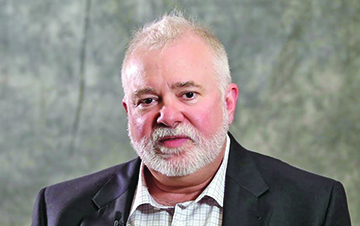
Dr. Terry Hildebrandt, PhD. lives and works in the Golden Triangle district which has become an urban hellhole.
morale of our police force when accused, violent criminals and drug dealers are released after the police risked their lives to arrest dangerous criminals,” Hildebrandt says. “I have also seen the frustration and fear of victims, who are subject to the same perpetrators over and over when these criminals are back in the community where they can re-offend.”
A Glimmer Of Hope
Despite the host of setbacks in his front yard, Terry Hildebrandt is focused on solutions. He is quick to point out that legislation which is counteractive to SB 21-271 has been introduced. “HB 22-1257 just passed the house,” he says. “It will help fix some of the issues if it passes in the Senate. [It] would add certain felony offenses, such as criminal extortion, enticement of a child, unlawful termination of pregnancy, and arson, back onto the ‘possession of a weapon by a previous offender’ (POWPO) list. However, it does not fix the issue of felons with drug convictions being allowed to possess guns,” he explains.
Extreme Measures
Some citizens are fed up, mistrustful of the legal system, and doubtful that law enforcement will come to their aid should they be accosted, assaulted, attacked, robbed, or worse. What then, you might ask, can you do to bolster your personal safety?
There are numerous Denver enterprises in the business of teaching people to protect themselves from violent criminals. This is not a new idea, rather, it has been a celebrated aspect of daily life in the Mountain West region since before the Mile High City was founded back in 1876. For a fair price, any able-bodied adult or minor with parental consent can learn to safely and proficiently operate, carry (18+ only), and maintain a firearm intended for self-protection. Places such as Lipstick Tactical (emphasizing women’s safety), BluCore Shooting Center, and Final Protective Line Academy are centers of education, awareness, and training for law-abiding citizens concerned with their personal safety. These and other similar enterprises are ideal places for garnering the proper training, knowledge, and testing required for obtaining a conceal and carry license.
If firearms are not your cup of tea but personal safety is, Denver offers a wealth of destinations for self-defense training in hand-to-hand combat styles such as Krav Maga, Jiu-Jitsu, Kung Fu, and many, many more. Folks too busy to take on a new discipline are wise, at the very least, to invest in practical means of deterring assailants such as pepper spray, bear spray, mace, or some similar, user-friendly device. If the government will not exact punishment against those who aim to harm law-abiding citizens — then the populace at large must assume sole responsibility for their own wellbeing. As for those who choose to harm themselves on the taxpayers’ dime — that mess, for now, is still your problem.



















